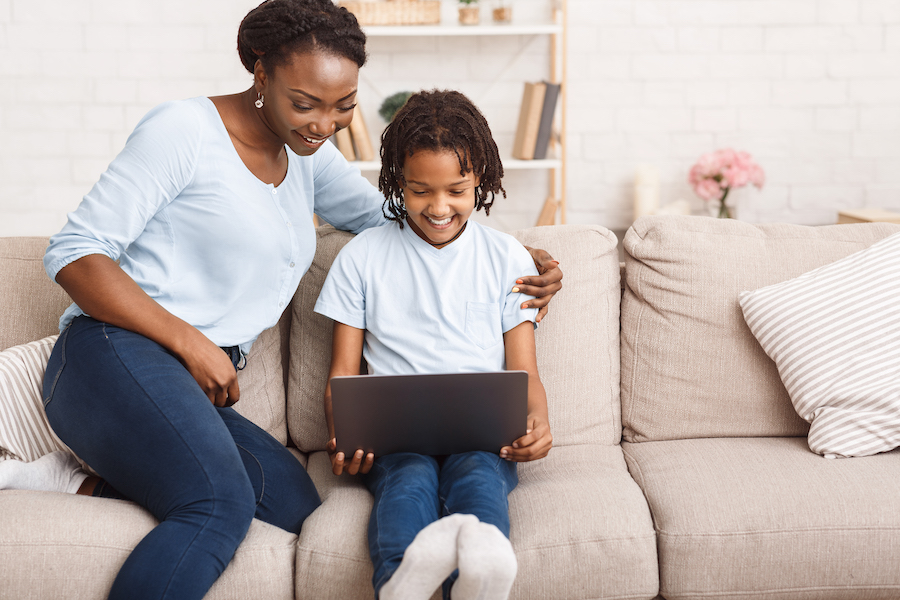COVID Virtual Learning Offers Lessons on Promoting Equity in Early Care and Education Settings
By Manica F. Ramos, Reprinted from Child Trends
The COVID-19 pandemic has become, essentially, a large-scale case study in which we are all involved, whether we like it or not. Nowhere is this reality more apparent than in the shift to remote learning, especially when it impacts very young children and families from under-resourced communities who are expected to keep up their usual progress as the rippling effects of COVID-19 widen already existing learning inequities.
On September 30, 2020, my colleague, Dr. Chrishana Lloyd, and I hosted a panel of researchers, education leaders, and parents to discuss the work of creating equitable remote learning in early care and education settings for young children in under-resourced communities. We were joined by Ms. Iesha Hicks, a Washington, DC-based parent who has engaged in remote learning with her two children—a 2-year-old and an 11-month-old—since March 2020, through Head Start; Dr. LaWanda Wesley, the director of quality enhancement and professional development of early education for the Oakland Unified School District; and Mr. Mitch Center, an education coach and consultant and the founder of Center Educational Consulting.
I was personally struck by two points shared during our discussion. The first was an observation from LaWanda that, in these times, we must “lead with grace.” The forced shift away from our daily routines and normal lives, and toward the constant need for adaptation and problem-solving, has created collective societal stress. As people with a stake in early care and education, we may all need periodic emotional check-ins with families. And parents, practitioners, and policymakers should remember to set aside time for self-care. The second insight came from Mitch, who encouraged providers to prioritize “connections over content” in all virtual learning efforts. Ideally, virtual classrooms and schooling can represent a space for children to focus on learning and to process the emotional and social effects of the pandemic.
These and similar themes were emphasized over the course of our discussion, as the panel shared the following considerations and strategies for policymakers and practitioners as they promote equitable learning opportunities in ECE settings:
The literature and evidence base are still sparse, so make informed guesses and share what you learn. We are learning a lot quickly but, in the meantime, continue to apply your best guesses with good intentions. Share your lessons learned with your colleagues and with those who are interested in supporting children and families.
Consider the ABCDs of virtual learning. Three in 10 adults in families who make below the federal poverty limit do not have a smartphone or a computer. Practitioners, policymakers, and other stakeholders should do their best to understand this reality and should help families with the ABCDs: Assistancenavigating software, broadband access, connectivity, and devices to access the internet. After all, virtual learning can only happen virtually, and following these ABCDs will be necessary to help children (at minimum) show up to learn.
Use developmentally appropriate options. Consider the available guidance on the importance of limiting screen time for children and allow free time for children to be children.
Return to routine, with flexibility: Children and families miss routines and crave some level of predictability. Create virtual schedules to offer structure but avoid schedules that are too stringent; to not allow flexibility means to dictate families’ day-to-day lives in their homes. Instead, help families find a balance that works for them.
Support families, who are essential contributors to children’s well-being. Early childhood stakeholders have “honored families as children’s first teachers,” but the extraordinary expectations placed on parents (e.g., tremendous time commitments, pressure to monitor all learning) go well beyond the praise that this expression can convey. During the discussion, Iesha remarked that many parents are simply overwhelmed. During normal times, it would be easier to rely on friends and families, but everyone is going through COVID-19 together and everyone is stretched thin.
Following the discussion, I had another realization: Virtual learning offers a literal window into children’s home lives that is not available in center-based and school settings. These glimpses into children’s homes can help teachers and child care providers offer more individualized instruction or grant them new insights into contextualizing learning. This new vantage point allows us, as early care and education stakeholders, to engage with each other at home and in each other’s personal spaces, providing a helpful reminder of our humanity.
To access the resource, please click here.










